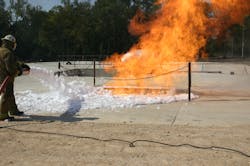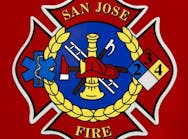Ethanol isn’t your granddaddy’s automotive fuel.
In a training video shown as part of the Massachusetts Firefighting Academy’s Ethanol for First Responders program, a frustrated engine company desperately tries to extinguish a car fire. The more water hosed onto the vehicle, the more stubbornly the flames react. The car in the video burned for hours in real time, despite efforts by firefighters who hooked up a large-diameter hose and flowed enough water to fill an Olympic-sized pool.
Worcester, Mass. Fire Lt. Martin Dyer, a fire academy instructor, put it simply when discussing the dangers of ethanol: “Dilution may not be the solution.” Consider this: 4,000 to 5,000 gallons of water are required to dilute 1,000 gallons of ethanol. “That ratio of one-to-four or one-to-five is humongous,” Dyer said.
Obviously, the firefighters in the video were unaware of the dangers presented by the bio-fuel, which is essentially hillbilly moonshine concocted from corn, soy beans or other vegetable products and made undrinkable to humans by adding small quantities of gasoline.
Automobile service stations label their pumps with the type of fuel being dispensed. E-10 denotes 10 percent ethanol. It’s important to note that the percentage of ethanol per gallon is increasing nationwide. In some regions, motorists are burning E-85.
As the training video showed, water is ineffective on an ethanol fire. The reason: ethanol is a polar solvent, a flammable liquid made of gasoline and alcohol that fully and immediately combines with water instead of separating, which is the opposite of what a firefighter attempting to knock down a car fire might expect.
Standard foam carried by most fire departments is relatively useless in dousing an ethanol fire simply because the foam isn’t alcohol-resistant.
To illustrate this point, the Massachusetts academy instructors ignited an ethanol fire in a steel pan mounted on a trailer in a parking lot. Standard firefighting foam was mixed and applied gently with a hoseline. Within seconds it dissolved and the flames rose up from the pan.
When alcohol-resistant, aqueous film-forming foam (AR-AFFF) was applied by banking the stream off a backsplash so that it gently fell upon the ethanol pool, the rising vapors and flames became blanketed by a foamy surface that transformed into a “polymeric membrane.” The fire was smothered.
AR-AFFF is formulated so that alcohol and other polar solvents will not dissolve this layer.
“The polymer in AR-AFFF acts as a physical barrier that forms on top of the fuel to prevent water in the foam bubble blanket from contacting the ethanol,” said Dominic Colletti, a national expert on firefighting foam. “Alcohol-resistant foams are the agent of choice when dealing with polar solvent fuel hazards, such as ethanol. The polymer prevents foam blanket degradation.”
Types of firefighting foam
During the training session, the AR-AFFF kept the flames in check, at least until an instructor sliced open the polymer surface with a plaster hook. Seconds later, the flames were dancing again. Judging by the astonished expressions, it was time for a lesson on foam concentrates.
Basically there are four major categories of Class B foam concentrate:
- Protein foams made from animal byproducts;
- Fluoroprotein foam and fluoroprotein film-forming foam (FFFP), which are basically the same as protein foams but include additives to make the foam spread faster and help level the blanket;
- Aqueous film-forming foam (AFFF), which is stocked aboard many fire trucks;
- Alcohol-resistant foam, which has film-forming properties similar to AFFF but will not dissolve in ethanol or other polar solvents.
When it comes to ethanol fires, alcohol-resistant foams and dry chemical extinguishers are the best choices.
The fire shown in the training video differed from a gasoline fire in another important way. Intense heat emanated from the fire, but there was no black smoke and no carbon. This unusual characteristic has given rise to a new rule of thumb: The absence of smoke doesn’t mean there’s no fire.
Unfortunately, this smokeless feature has been instrumental in convincing environmentalists that ethanol is a green product, environmentally friendly and healthier for the atmosphere. Problem is, if you’re a firefighter and can’t see smoke, it’s harder to tell where the radius of dangerous heat begins and ends.
During the training, a thermal-imaging camera outlined the flames and the white-hot zone extending about three feet from the fire’s epicenter. The instructors emphasized that firefighters must be attentive to this invisible heat zone.
To further complicate the situation, ethanol is colorless, highly flammable, conducts electricity and can easily turn a runoff of spilled fuel into a river of flames.
“By adding water to an ethanol fire, you can actually make it worse,” Dyer explained. “Water spreads the ethanol, which then spreads the fire. If it rolls down the road, you might set other cars on fire. It can also enter storm drains, carrying the fire with it.”
Despite these dangers, the use of ethanol is on the rise. There’s a widespread belief that the adoption of ethanol as the primary automotive fuel in America will decrease the nation’s reliance on Middle East oil.
A result of this thinking has led to a dramatic increase in the number of ethanol fires involving motor vehicles or railway tankers over the past decade in the U.S. The growing demand for biofuels like ethanol has also caused the price of domestic corn to skyrocket by 70 percent over the past two years, an impact that often goes overlooked by consumers.
Ethanol common on U.S. roadways
Motor vehicles using higher ratios of ethanol fuel are now common on U.S. highways, particularly in the Midwest where corn and other bio-fuels are plentiful. Such biofuels are also found at most service stations on the West Coast and the trend is catching on along the eastern seaboard.
Consider this: An ethanol fire involving a derailed train tanker in a relatively unpopulated rural area might be allowed to burn itself out, but a motor vehicle engulfed in ethanol-fed flames on a metropolitan bridge or urban roadway must be readily extinguished.
The Department of Fire Services (DFS) in Massachusetts is concerned about the increase in tanker trucks carrying 10,000 to 12,000 gallons of ethanol, and railway tanker cars carrying an average of 30,000 gallons. Each week in Massachusetts, approximately 40 tanker trucks carrying E-95 (95 percent ethanol) fuel drive along the Massachusetts Turnpike.
“There are a lot of big tanker trucks carrying ethanol roaming the roadways.” said Colletti. “While an incident can happen in any town, today or tomorrow, these incidents tend to be low frequency, so the urgency to train and get information on how to handle is low. From a training perspective, it’s similar in concept to other low-frequency events, like terrorism, clandestine drug labs, etc. that we deal with.”
According to the DFS, 20.6 million gallons of ethanol are currently stored in Massachusetts, mostly in bulk storage tanks or sitting in rail cars, while another 19.9 million gallons are transported annually by barge.
Experts contend fire departments nationwide must prepare for the inevitable ethanol incidents by carrying the correct alcohol-resistant foam on their trucks along with additional dry chemical extinguishers.
“We may have to change what we’re buying,” said Dyer, referring to the need to purchase AR-AFFF and carry more than one 20-pound dry chemical extinguisher aboard an engine. “You must realize this is not a hydrocarbon fire. You may have to swallow your pride and say I can’t handle this with one 20-pound extinguisher.”
Colletti suggested two 50-pound extinguishers could become the minimum equipment required for an engine company, but still might not do the job. “Dry chemical breaks the chain reaction to put out the fire, but it’s not going to stop re-ignition from fuel vapor release. That would be stopped or secured by a foam blanket,” he said.
Fire departments that once depended on foam assistance from a nearby airport should keep in mind standard aircraft firefighting foam is not alcohol resistant. However, the airport truck can still provide dry chemical support.
When large quantities of ethanol are involved, most fire departments evacuate the area and let the liquid burn off. However, when ethanol decomposes on the ground, it leaches into the soil and creates flammable methane gas, which presents firefighters with yet another danger.
New placards—a red diamond with the number 1170 in the center, a flame at the top and the number 3 at the bottom to signify flammable liquid—identify cargo as ethyl alcohol, aka ethanol.
“Firefighters need to know about ethanol and they have to change their tactics,” Dyer said.
Colletti agreed. “Everyone needs to understand that the majority of fuels rolling around today, with the exception of diesel, are alcohol-based or treated,” he said. “We have to plan for that, which means having alcohol-resistant foam in hand and knowing how to apply it.”
In Massachusetts, that sort of knowledge can be obtained at the firefighting academy’s flammable gas school. But not every state in the U.S. has such a facility, so fire departments are often left to improvise training against a new foe they barely understand.
When Colletti teaches a class on ethanol dangers, he begins by confronting the firefighters with a few simple questions: “I ask them, do you have a gas station in your town? Yes. How did the gas get there, an underground pipe? No. Oh, by truck? Yes. By big fuel tankers rolling down the road? Yes. And do people live near that gas station? Yes. And do they expect you know what to do if the truck catches fire? Yes. Do you? Can you deal with it? No. So what are you doing about it?”
Colletti said some departments don’t have an effective plan for timely fire control and extinguishment, adding that increased awareness followed by locally funded training and equipment, would be steps in the right direction.
DAVID LISCIO is a call firefighter/EMT in Nahant, MA.






